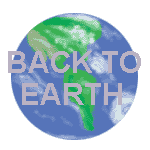
Places, Earth
A Wine Free Trip Through Wine Country
A Wine Free Trip Through Wine Country


|
Places, Earth
A Wine Free Trip Through Wine Country |

|
Day 1, Saturday.It was Saturday morning, the first day of our Memorial Day weekend. We had just flown into San Jose International Airport and were heading south in our rental car. A year earlier, we had attended the 25th Gilroy Garlic Festival and visited Mission San Juan Bautista with my in-laws. We began this trip by attending the 25th Morgan Hill Mushroom Mardi Gras and revisiting Mission San Juan Bautista, this time I wandered alone as my wife napped in the car.The Morgan Hill Mushroom Mardi Gras is not quite as grand as the Garlic Festival produced by Gilroy just 15 minutes south, but we are glad that we attended. Anyway, it was late May and the weather was cooler than last year's Garlic Festival in late July at 100 degrees plus. The festival was spread over a large city park and did not feel overly crowed. |
| The usual booths for various venders lined the outer edges with a small lake in the center. Food included fried mushrooms, deep fried mushroom, Portabello mushroom sandwiches, garlic bread smothered in fried mushrooms. A local rock radio station provided entertainment from a stage in the northern section of the park. We stayed about two hours, bought some flavored garlic, and headed for San Juan Bautista. |
|
San Juan Bautista Mission is part of San Juan Bautista State Historic Park and San Juan Bautista is a quaint little town with numerous shops and restaurants catering to tourists. I had photographed the mission a year earlier, but wanted additional shots for my Missions web site. I wondered about and found some new angles to photograph. It seems no mater how often I visit a mission, I can always find something new if I hunt around long enough. We returned to Morgan Hill for dinner at Erik's DeliCafé. My wife's parents had taken us here several times, but they had moved away just a month before. We got our sandwiches to go and drove north on US Highway 101 and then Interstate Highway 680. I chose this route to get us away from the traffic along the east side of San Francisco Bay. It proved a pleasant drive, almost a country drive as this route was more rural than urban and skirted the east |
| edge of the East Bay cities including Fremont, Oakland, and Berkeley. We drove across the Benicia-Martinez Bridge, crossing the Carquinez Strait which separates San Pablo Bay and Suisun Bay and is all part of the San Francisco Bay system. From the bridge, we could see the Navy's Moth Ball Fleet at anchor in Suisun Bay, awaiting reactivation or the scrap yard. A few miles later, we turned west onto State Highway 12. |
|
State Highway 12 is one of those roads that jogs and sometimes merges with another road you must drive a few miles to get back to it. Follow the signs and eventually you'll get there. The drive was picturesque as we wound our way through the countryside. I made a quick stop at Schellville to photograph a rustic old Railroad Depot. It all looked like it had been disused for some time and on a siding sat an old locomotive with a unique paint scheme. Bits and pieces of railroad equipment were scattered throughout the yard. Only as I was getting back into the car did I notice the sign that said, "Railroad Property, No stopping." Honest, I only took photographs from a distance. Back on the road and after another mile or so, we arrived at our primary destination, Sonoma. I was surprised by the size of Sonoma. Somehow, I expected it to be smaller. I stopped on the way into town to photograph yet another El Camino Real marker bell. Our primary objective was to see Mission San Francisco Salano de Sonoma and I was a little anxious after missing seeing Mission San Miguel by only three days because of the December 22, 2003 earthquake. We stopped to photograph the mission even though it was getting late - just in case. Imagine my disappointment when I first glimpsed the mission and realized that I would replace my only photo of the mission, taken many years earlier and showing a piece of construction equipment in front, with a new photo of the mission being re-roofed. We took a few photos of the mission and other buildings in the Historic Park in the waning spring light. This also gave me the opportunity to get acquainted with the town to help plan our longer planned visit on Monday. It was another relaxing country drive the 30 minutes to our final destination for the day, Santa Rosa. Our room was waiting and we settled off to sleep. |
| We started out early with a quick breakfast and attended services at a beautiful church in the Historic District. Then we headed north on Calistoga Road. We transitioned to Petrified Forest Road and crossed into Napa County. South on State Highway 128 a few miles, through the historic town of Calistoga, and we arrived at our first stop for Day 2. |
| Bale Grist Mill State Historic Park is less than an acre in size and features one of the last grist mills. Once common throughout the country, most have been lost to age, deterioration, progress, or fire. Bale Grist Mill is a jewel. Park rangers perform regular demonstrations of milling and explain how important these structures once were, both to bodily sustenance and as a community gathering place where farmers could "mill around" or gossip while awaiting their flour. The water is now supplied by a pump and recirculated, but the mill is otherwise remarkably preserved. |
|
A quick drive north back to Calistoga and we spent several hours in this historic town. We began at the Sharpsteen Museum which explains the history of the town and how the famous springs drew people to the healthy waters. Two bottled water companies trace their roots back to these waters. The town is filled with the boutiques and eating establishments that attract residents of the Bay Area on the weekends. We enjoyed our lunch at Nicola's. My wife bought a large bag of salt water taffy at a candy store and was happy. We decided that we didn't have time to see the Old Faithful Geyser of Calistoga. The Geyser is one of only three constant and predictable geysers in the world. Eruption occur approximately every 30 minutes. Hopefully it will remain constant until our next visit to Wine Country. |
|
We also did not have time to stop at the Petrified Forest. We asked at the entrance and were told it takes about 30 minutes, so we decided to go in. We spent about an hour and a half at the Petrified Forest. My first impression wasn't so good, but it got better. Just as we were half way through the best part, a guide came by and invited us to a special tour. He lead us through native vegetation and explained about manzanita and madron, both smooth bark-free trees. The tour turned around at an ash fall from which we could see Mount Saint Helena, about six miles to the north. It was this volcano that erupted millions of years ago and blasted down the trees and then covered those trees with volcanic ash. It was the ash that allowed these trees to become petrified. My wife is not as scientificaly minded as I am and it always surprises me how much she enjoys things like this. There are a half dozen or so very large petrified trees, some specimens over one hundred feet long. The petrification is so fine, we could easily see the rings of the trees, the texture of the bark, and even insect damage. All the trees are pointing in the same direction, the direction that the blast from the volcano was traveling. About a hundred years ago, the tops of these trees were discovered protruding from the ground. The rest of the trees were then excavated to expose the entire length. The trail makes a large loop which eventually brought us back to the entrance. A gift shop sells specimens of petrifies wood. Having stayed longer at the Petrified Forest than we intended, we had to scratch the Luther Burbank Home and Gardens in Santa Rosa. These gardens where the famous botanist experimented with plants will be high on our list for our next visit. When my wife heard that the Charles M. Shultz Museum and Research Center was in Santa Rosa, that became her top priority. This museum was delightful. In addition to the Peanuts memorabilia that you would expect, there is a wall of Peanuts comics that were never intended for publication. These included a series of our favorite comic characters at later stages of their lives, saying what they would really like to say, and generally not being the way we expect. The museum is across the street from the skating rink where Mr. Shultz enjoyed a daily meal and undoubtedly found inspiration. |
|
Mr. Shultz was very active in community activities and the Museum is well located here. At the museum, we found a brochure on an Art Walk that begins with a Peanuts character sculpture a few miles away in Depot Park. After driving around a while, we found the second sculpture and parked across the street from a small park beside the river. A number of the sculptures, murals, and painted benches of the Art Walk were clustered around this section of the river. We picked up the Walking Tour with art piece #2. There are 38 art pieces in total, but this may change as some pieces are rotated in and out of the exhibit. We drove on and parked again closer to the Civic Center where another cluster of sculptures are located. In the fading light of this May Sunday evening, we found about a third of the sculptures and many of the 72 painted benches. We also found a few of Santa Rosa's homeless, but unlike other cities, they somehow seemed more polite and their shopping carts were better maintained. We returned to our motel and had another restful night. |
Day 3, Monday, Memorial Day.Monday morning, we sat in the motel coffee shop eating our breakfast when I noticed in the distance, two hot-air balloons drifting by. I ran back to our room and grabbed my camera with a zoom lens and captured the image. Later I learned that these balloon rides are operated as a business. We checked out early and headed out of town, first stopping off to see a few more pieces of the Art Walk. We returned to Sonoma the way we came. We passed Jack London State Historic Park with the ruins of Jack London's Wolf House which tragically burned to the ground shortly after completion. This, and Robert Louis Stevenson State Park and few miles north of Calistoga, are also high on our list to visit the next time. We arrived in Sonoma about an hour and a half before the Mission and Historic Park opened, so we photographed what we could before the tourists arrived.We stopped by the Visitor Center which is housed in a former Carnegie Library. It seemed that we were the only adults in the Wine Country that Memorial Day weekend who were not looking for wineries. We learned of many more historic homes, adobes, and building in the area which we filed away for our next visit. |
| We had seen all of the except one. Finally that Mission was open and we quickly began our visit to our last mission. Mission San Francisco Solano de Sonoma, the last mission founded, the last link in the chain, the only mission founded by Mexico, and the only mission founded without approval of the Church was founded on July 4, 1823 by Father Jose Altimira and is now part of Sonoma State Historic Park. Sonoma State Historic Park includes the Mission, Barracks, The Blue Wing Inn, Tascano Hotel, The Servant's Wing to the long ago demolished La Casa Grande, and a few blocks away the Vallejo Home. Your admission ticket includes Petaluma Adobe State Historic Park just west of Petaluma several miles west of Sonoma, but our schedule didn't allow for us to visit this time. |
| We were waiting at the entrance to the Mission when the Park Ranger arrived to open up. The existing Mission building is an L with one side for a museum and one for the church. Masses are no longer held at the Mission, so there are no seats in the church, only the decorations and accessories. The museum contains the usual artifacts of Indian life at the Mission such as stone tools and adobe tile making. Behind the Mission is a courtyard with a fountain and a work shop. |
|
Across the street is the Barracks with its own small museum and gift shop. Behind the Barracks is a courtyard with a caretta, a small two-wheeled cart. Upstairs were a few rooms and a balcony that looks out over the park, but there were no exhibits. Next to the Barracks is the Tascano Hotel. We took a docent lead tour which explained the importance of this building. Next to the Tascano Hotel are a few other old buildings arranged about an open area, but I was not able to learn what their importance was. Beside this open space is the Servant's Wing to La Casa Grande, a large house that unfortunately no longer exists. The Servant's Wing contained no exhibits. The Blue Wing Inn now is home to a restaurant. We didn't have time for the Vallejo Home. Sonoma also includes two other historic homes and Depot Park. The Depot Park Museum building is only open on the weekends and this was Monday, so we missed this. We didn't have time to see the two historic house, so again, we added them to our plans for next year. One last stop on the way out of town Train Town, but decided to put that off until the next time as well. Clearly, we can make two more trips from the museums, parks, and historic buildings we missed. |
| We reversed our path back to the airport, arriving about two hours early for our flight. To kill a little time, we revisited Mission Santa Clara which is only about a mile from the airport. I like to empty my camera before going through airport security, so it was a good way to use up the remaining film. Mission Santa Clara was the nucleus of, and is now within, the first University in California. The current church is the sixth church, built about 1928. What survives of the original mission are a few adjacent adobe structures. A rather unique marker of an earlier church lies near the entrance to the campus where a grassy area surrounds what looks like a rectangular side walk which extends into an adjacent street. This makes the foundation of an earlier church. We were still early for our flight and I filled the time watching a kinetic sculpture in the airport waiting area. |

|

|

|
| Note:This is not the official site for any of the places shown in Places Earth. Places Earth is not responsible for accuracy of the information. Hours of operations, prices, exhibits, and sometimes locations are subject to change without notice. |
|
Support this Web Site I hope that you find this web site helpful. It started because of my love for Architecture and interest in History and a desire to share my photographs and tales of my adventures. I don't allow paid advertising. This web site is for your benefit and enjoyment and I make no profit on it. For twenty years it has been supported primarily from my regular paycheck as a Set Designer. If you are in the need of a designer, please see my Set Designer portfolio site Set Design Portfolio. |
|
Links |

|
This site maintained by Kenneth A. Larson. Copyright © 2004 - 2023, Kenneth A. Larson. All Rights Reserved. Website content including photographic and graphic images may not be redistributed for use on another website. |

|

|

|